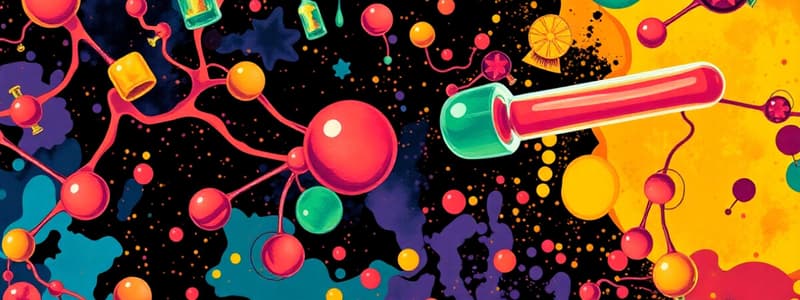Podcast
Questions and Answers
What are the primary indications for using Norepinephrine?
What are the primary indications for using Norepinephrine?
- Hypotensive shock (correct)
- Hypertension
- Anaphylaxis
- Cardiac Arrest (correct)
Which of the following medications is a direct-acting non-selective agonist?
Which of the following medications is a direct-acting non-selective agonist?
- Clonidine
- Epinephrine (correct)
- Norepinephrine
- Pseudoephedrine
What is a contraindication for using Epinephrine?
What is a contraindication for using Epinephrine?
- Anaphylaxis
- Decongestion
- Hypotensive shock
- Hypertension (correct)
What are the common side effects associated with Dopamine?
What are the common side effects associated with Dopamine?
Which mechanism of action is associated with Clonidine?
Which mechanism of action is associated with Clonidine?
The primary action of Phenylephrine is vasoconstriction. What is one of its main side effects?
The primary action of Phenylephrine is vasoconstriction. What is one of its main side effects?
Which of the following best describes the indications for using Pseudoephedrine?
Which of the following best describes the indications for using Pseudoephedrine?
What is a potential side effect for patients taking Clonidine?
What is a potential side effect for patients taking Clonidine?
Flashcards
Epinephrine's effect on blood pressure
Epinephrine's effect on blood pressure
Epinephrine increases blood pressure by causing vasoconstriction (alpha1 receptors) and increasing heart rate and contractility (beta1 receptors).
Norepinephrine's primary action
Norepinephrine's primary action
Norepinephrine primarily causes vasoconstriction, increasing blood pressure, and also affects heart rate and contractility.
Dopamine's role in vasoconstriction
Dopamine's role in vasoconstriction
Dopamine can cause vasoconstriction through D1 and alpha1 receptors, but also has effects on heart rate and contractility through beta1 receptors.
Ephedrine's mechanism of action
Ephedrine's mechanism of action
Signup and view all the flashcards
Clonidine's impact on blood pressure
Clonidine's impact on blood pressure
Signup and view all the flashcards
Phenylephrine's impact on blood vessels
Phenylephrine's impact on blood vessels
Signup and view all the flashcards
Epinephrine's indications
Epinephrine's indications
Signup and view all the flashcards
Clonidine's indications
Clonidine's indications
Signup and view all the flashcards
Study Notes
Agonist Drugs
-
Direct-Acting:
- Epinephrine (Epi): MOA: Vasoconstriction, ↑ HR, ↑ BP, ↑ force, ↑ AV conduction, MI. Side effects: Arrhythmias, anxiety, headache, anaphylaxis. Indications: Arrhythmias, cardiac arrest, MI. Contraindications: Glaucoma, halothane anesthetic.
- Norepinephrine: MOA: Vasoconstriction, ↑ HR, ↑ BP, ↑ force, ↑ AV conduction, MI. Side effects: Arrhythmias, cardiac arrest, hypertension, angina pectoris, hypotension. Indications: Hypertension, cardiac arrest. Contraindications: Hypotensive shock, pheochromocytoma.
-
Mixed-Acting:
- Dopamine: MOA: D1, B1. Side effects: Arrhythmias, hypertension, angina, acute HF. Indications: Hypotensive shock, acute HF, angina. Contraindications: Acidosis.
-
Mixed-Acting (continued):
- Ephedrine: MOA: ↑ NE & E, ↑ HR, ↑ BP. Side effects: Arrhythmias, ↑ BP, anxiety. Indications: Bronchodilation, nasal decongestion. Contraindications: Not mentioned.
- Pseudoephedrine: MOA: ↑ NE, ↑ HR, ↑ BP. Side effects: ↑ BP, bradycardia, anxiety, vomiting, chest pain. Indications: Nasal decongestion. Contraindications: Not mentioned.
-
Selective Agonists:
- Phenylephrine: MOA: α1 receptor activation, ↑ BP. Side effects: Hypertension, bradycardia, anxiety. Indications: Decongestant. Contraindications: Overactive thyroid, hypersensitivity.
- Oxymetazoline: MOA: α1 activation, ↑ BP. Side effects: Hypertensive shock, arrhythmias. Indications: Nasal decongestion. Contraindications: Not mentioned.
α2-Agonists
-
Clonidine: MOA: ↓ NE release, ↓ HR, ↓ BP. Side effects: Hypotension, bradycardia, insomnia. Indications: Hypertension. Contraindications: Pregnancy, heart attack, eye issues.
-
Methyldopa: MOA: ↓ NE release, ↓ HR, ↓ BP. Side effects: Hypotension, fatigue. Indications: Hypertension. Contraindications: Not widely used due to side effects.
Studying That Suits You
Use AI to generate personalized quizzes and flashcards to suit your learning preferences.




